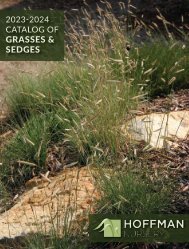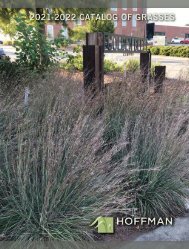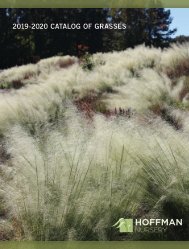2022-2023 Hoffman Nursery Catalog of Grasses & Sedges
Create successful ePaper yourself
Turn your PDF publications into a flip-book with our unique Google optimized e-Paper software.
AMM-AND<br />
Ammophila breviligulata<br />
ANDROPOGON<br />
Ammophila breviligulata<br />
AMERICAN BEACH GRASS<br />
Native to sand dunes <strong>of</strong> the Atlantic Ocean from<br />
New England to South Carolina and along the<br />
shores <strong>of</strong> the Great Lakes, American Beach<br />
Grass spreads by rhizomes and is used extensively<br />
in dune stabilization. It produces beautiful<br />
seed heads that are six-to-twelve-inches long.<br />
Plant in sun and sand. Very tolerant <strong>of</strong> salt spray<br />
and heat.<br />
Cool season, dark green, 2’, 3’ with blooms, sun,<br />
dry (sand), flowers midsummer, Zones 3-8, Origin:<br />
Eastern North America and Great Lakes<br />
Andropogon gerardii 'Blackhawks'<br />
PP27949<br />
BLACKHAWKS BIG BLUESTEM<br />
The native adaptability <strong>of</strong> Big Bluestem gets an<br />
infusion <strong>of</strong> color with 'Blackhawks'. Dark green<br />
foliage in spring is followed by midsummer<br />
purples, burgundies, and reds. Cooler fall nights<br />
bring a dark, rich purple that’s almost black.<br />
Shorter and more upright than the species, it<br />
tolerates a range <strong>of</strong> soil conditions but prefers<br />
well-drained soils in full sun. Deer resistant.<br />
Introduced by Intrinsic Perennial Gardens in Hebron,<br />
IL. Unauthorized propagation prohibited.<br />
Warm season, purple, 1.5’, 4-5’ with blooms, sun,<br />
dry-average, flowers midsummer, Zones 3-9, Origin:<br />
North America<br />
Andropogon gerardii ‘Blackhawks’ PP27949<br />
ANDROPOGON<br />
The Andropogon species we grow are native to North America and hold ecological importance.<br />
A. gerardii is one <strong>of</strong> the dominant species in tallgrass prairies, many are used in restoration, and<br />
others colonize disturbed sites. These workhorses are excellent not only for mass plantings but<br />
also in perennial beds and managed landscapes. They’re tough and resilient with deep, fibrous<br />
root systems that help them stabilize soils and withstand drought. They are warm-season bunchgrasses<br />
with most North American species occurring in the eastern half <strong>of</strong> the country. Many <strong>of</strong>fer<br />
food, cover, and nesting material to birds and other wildlife.<br />
Andropogon gerardii<br />
BIG BLUESTEM<br />
The dominant species in our once vast tallgrass<br />
prairie, Big Bluestem’s range extends across<br />
most <strong>of</strong> North America. Lends itself to prairies,<br />
meadows, naturalizing, and restoration projects.<br />
Blue green foliage transitions to red, orange and<br />
purple in fall. Flowering culms rise high above<br />
foliage; inflorescences resemble turkey feet.<br />
Provides shelter and food for wildlife. It performs<br />
in range <strong>of</strong> conditions, including infertile, dryaverage,<br />
sandy, or clay soils. Grows freely in<br />
moist, fertile soils but may flop.<br />
Warm season, blue-green, 5’, 7’ with blooms, sun,<br />
dry-moist, flowers midsummer, Zones 3-8, Origin:<br />
North America<br />
Andropogon gerardii<br />
Courtesy <strong>of</strong> Hortech, Inc.<br />
Andropogon gerardii Karl’s Cousin ® (‘Nondwhr’)<br />
Andropogon gerardii 'Red October' PP26283<br />
RED OCTOBER BIG BLUESTEM<br />
This Big Bluestem has deep green leaves with<br />
red highlights in spring. In fall, the red increases<br />
and deepens to burgundy. After first frost, foliage<br />
turns candy-apple red and scarlet. Even the<br />
seed heads are red. This native grass is tough<br />
like the species. Introduced by Intrinsic Perennial<br />
Gardens <strong>of</strong> Hebron, IL. Unauthorized propagation<br />
prohibited.<br />
Warm season, green w/red tips, 2’-4’, 5’-6’ with<br />
blooms, sun, dry-average, flowers midsummer, Zones<br />
3-9, Origin: North America<br />
Andropogon gerardii Karl’s Cousin ®<br />
('Nondwhr')<br />
KARL’S COUSIN © BIG BLUESTEM<br />
Described as the 'Karl Foerster' <strong>of</strong> Big Bluestem,<br />
this native cultivar was selected by Dave MacKenzie<br />
<strong>of</strong> Hortech in Nunica, MI. Chosen for its<br />
tight, upright, architectural habit, its coloration is<br />
a beautiful bonus. Basal foliage starts out greenblue,<br />
with stems, leaves, and flowers turning<br />
shades <strong>of</strong> purple-blue as the season progresses.<br />
Karl’s Cousin has the resilience and versatility <strong>of</strong><br />
the species and resists flopping.<br />
Warm season, green-blue, 3.5’-4.5’, 6-7’ with blooms,<br />
sun-part sun, dry-average; flowers midsummer, Zones<br />
4-8, Origin: North America<br />
Courtesy <strong>of</strong> Intrinsic Perennial Gardens<br />
26<br />
We grow good grass! ®<br />
1-800-203-8590 h<strong>of</strong>fmannursery.com<br />
Andropogon gerardii ‘Red October’ PP26283 27








